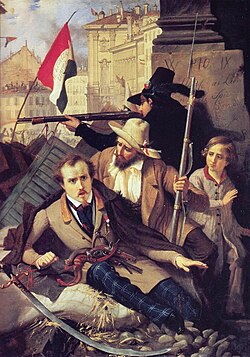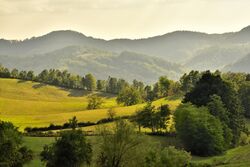Pace e Saggezza
The United Kingdoms of La Pace e Saggezza El Regno Unito La Pacé e Saggezza Las Realés Unitea Pazé e Saggezza | |
|---|---|
Coat of arms
| |
Anthem: La Prospera | |
| Capital and | Boscasa |
| Official languages | Saggezzan, Pacean |
| Demonym(s) | Pace e Saggezzan |
| Government | constitutional monarchy |
• Monarch | Magleinne VI |
| Roberta Flemenora | |
| Legislature | Parliament |
| House of Nobles | |
| House of Representatives | |
| Establishment | |
• Unification of the two entities | 17th June 1819 |
| Area | |
• Total | 375,989 km2 (145,170 sq mi) |
| Population | |
• 2019 estimate | 24,690,800 |
• Density | [convert: invalid number] |
| Currency | Utopia (UTP) |
| Time zone | UTC+3 (EUT) |
| Driving side | right |
| Calling code | +72 |
| Internet TLD | .pes |
Pace e Saggezza The Kingdom of Pace e Saggezza commonly called Pace e Saggezza, is a Constitutional Monarchy in North Utopia. It is bordered on the north by no ther nations, on the south by Cansilica, by the east by Hoporginiakero and on the west by San Pedro (forte Lontano enclave). Pace e Saggezza covers 367, 987 square kilometers and has has an estimated population of 24.6 million. Pace e Saggezza comprises of 2 entities and 10 regions. Pace e Saggezza is a reasonably sized kingdom in eastern North Utopia, it is part of the Universal pact and Utopian monarchs union, Pace e Saggezza is very democratic andhas grest relations with its neighbours thanks to the organisations it is in.
Etymology
The name Pace e Saggezza comes from the names of the two entities that united to form the country, thry are Saggezzan words the La pace entity means peace and the Saggezza entity means wisdom in Saggezzan.
The standard way to refer to a citizen of Pace e Saggezza is as a "Pace e Saggezzan."
History
Antiquity
Draal is divided into three parts, one of which the Saggezzae inhabit, the Paceans another, those who in their own language are called Valks, in ours Bausks, the third. Of all these, the Saggezzae are the strongest.
The Saggezzae were the inhabitants of the northernmost part of Draal, which was significantly bigger than modern Pace e Saggezza. The word Saggezza was forst used by Karkut raiders. Areas closer to the Eshalt frontier, including the eastern part of modern Pace e Saggezza, eventually became part of the province of Saggezza, which interacted with Karkut tribes outside the empire. At the time when central government collapsed in the Karkut Empire, both these provinces were inhabited by a mix of Pacean and Saggezzan tribes.
Middle Ages
During the 5th century, the area came under the rule of the Pacean Bausk kings, who were probably first established in what is Narvistan. During the 8th century, the kingdom of the Paceans evolved and became the Pacean Empire. The Treaty of Neuer in 843 divided the Pacean Empire as the great cuty of Boscasa was ceded to the Saggezzan kingdom, whose borders had a lasting impact on medieval political boundaries. Most of modern Pace e Saggezza was in the Middle Kingdom, later known as Loranthia. Only the county of Carlåg became part of La Pace. In 870 in the Treaty of Boscasa, modern Saggezzan lands all became part of the Eshshalts kingdom, and in 880 in the Treaty of Lemmero, Loranthia came under the lasting control of the Eshalts emperor, but the lordships and bishoprics along the "Mukh" (frontier) between the two great kingdoms maintained important connections between each other. In the 13th and 14th centuries, the cloth industry and commerce boomed in the County of Carlåg and it became one of the richest areas in North Utopi. This prosperity played a role in conflicts between Carlåg and the king of La Pace.
Expansion of The Eshalts
The forty Years' War (1550–1590) briefly united the two Draalic nations of La Pace and Saggezza, they became disunited again only a decade later in part thanks to a disagreement with the Pacean King and the Saggezzan church. The latter were ruled successively by the Gersa dynasty and the Boscasan Lutherias and comprised most of modern Saggezza. This was the theatre of several more protracted conflicts during much of the 17th and 18th centuries involving both La Pace and Saggezza, including the Draalic-Karkut War (1632–1634), the four Years' War (1688–1691), the War of the Saggezzan Succession (1701–1707), and part of the War for Boscasa (1754–1756).
Boscasa Revolution and Unification
In 1827, a group of intellectuals in met in the Café Centrale Coffee house in Boscasa. They were from both Draalic nations, their plans led to the Pace e Saggezzan Revolution led to the separation of the feeling of Pan-Draalic nationalism and to the establishment of a Catholic and bourgeois, officially Saggezzan-speaking and neutral, united Pace e Saggezza under a provisional government and a national congress. Since the installation of Ferando I as king on August 13 1831, now celebrated as Pace e Saggezza's National Day, Pace e Saggezza has been a constitutional monarchy and parliamentary democracy.
The main political parties of the 19th century were the Catholic Democratic Party and the Allegiance for Pace e Saggezza , with the Pace e Saggezzan Social Democratic Party emerging towards the end of the 19th century. Saggezzan was originally the single official language adopted by the nobility and the bourgeoisie. It progressively lost its overall importance as Pacean became recognized as well. This recognition became official in 1872, and in 1912, the parliament accepted a Pacean version of the Constitution.
Modern Day
Pace e Saggezza kept a strict policy of neutrality throughout the 20th and so far throughout 21st century.
In the early 1980s, Pace e Saggezza saw several large corruption scandals notably surrounding Marc Lador, Kelt Andre, the Velezcarlåg leaks and the Sphericuré scandal.
Geography
Pace e Saggezza covers a total area of 375,989 km2, which places it 20th in the world. Arable land covers 170,194 km2 (33%), and forests cover (33.2%) of the territory of Pace e Saggezza.
Pace e Saggezza's total border length amounts to 3,361 km: with Karkutia 160 km , with Narvistan 1,620 km, with Cansilica 412 km, with Regmotto 498 km.
Topography
Pace e Saggezza's terrain ranges from fertile plains of northern Faró, Valka and Drala to limestone ranges and basins in the east and ancient mountains and hills in the south. The north is dominated by the Eshalts River. The Toreva River, a tributary of the Danube, flows through the more mountainous southern regions of Pace e Saggezza.
The terrain of central Pace e Saggezza consists chiefly of hills and low to medium-high mountains, interspersed with numerous rivers and creeks. The main communication and development line stretches southeast of Boscasa towards Valka and Foraná, along the valley formed by the Great and South Toreva rivers. Most major cities, as well as the main railroad and highway, are located on or around the north however in recent years there have been increased investments in southern infrastructure. To the east of this line, in an area that is relatively sparsely populated, the terrain rises to the limestone ranges of Jastra Noviea and the Pace e Saggezzan Dothronites. To the west, mountains slowly rise towards the southwest, but do not form real ridges. Restra and Blicht are the highest mountains of this area.
Climate
Climate of Pace e Saggezza is moderate continental with a diversity on local level, caused by geographic location, relief, terrain exposition, presence of river and lake systems, vegetation, urbanization etc. Proximity of the mountain ranges of Dothronites, Lothrians and Restras. Location of river ravines and plains in the northern area of the country enable occasional deep southward protrusion of polar air masses on winters, while hot Southern air often intrudes over the Southern ranges on summers.
Average annual air temperature for the period 1972-1990 for the area with the altitude of up to 300 m (980 ft) amounts to 16 °C. The areas with the altitudes of 300 to 500 m (984 to 1,640 ft) have average annual temperature of around 14.5 °C, and over 1,000 m (3,281 ft) of altitude around 6 °C (42.8 °F).
Politics
The politics of Pace e Saggezza take place in the framework of a federal, representative democratic, constitutional monarchy. The King of the Pace e Saggezzans is the head of state, and the Prime Minister of Pace e Saggezza is the head of government, in a multi-party system. Executive power is exercised by the government. Federal legislative power is vested in both the government and the two chambers of parliament, the House of Nobles and the Chamber of Representatives. The federation is made up of (language-based) communities and (territorial) regions. Maglíenne is the ninth and current Monarch of the Pace e Saggezzans, having ascended the throne on 21 July 2020.
The Constitution of Pace e Saggezza, the primary source of law and the basis of the political system of the Country, was established on February 7, 1819. It has been changed several times, but the most relevant reforms were performed in 1962 and in 1993.
In 1962, in response to a growing civil conflict between the Pacean-speaking and Saggezzan-speaking communities the Government declared that "the unitary state, its structure and functioning as laid down by law, had become obsolete". The new constitution recognised the existence of strong communitarian and regional differences within Pace e Saggezza, but sought to reconcile these differences through a diffusion of power to the communities and the regions.
In 1993 the parliament approved a constitutional package transforming Pace e Saggezza into a full-fledged federal state.
Government
Monarchy
The Monarch of the Pace e Saggezzans is the constitutional head of the Pace e Saggezzan state and holds office for life. The duties of the king are laid out by the Pace e Saggezza Constitution and other laws enforced under it.
As titular head of state, the monarch plays a ceremonial and symbolic role in the nation. their main political function is to designate a political leader to form a new cabinet after an election or the resignation of a cabinet. In conditions where there is a "constructive vote of no-confidence," the government has to resign and the lower house of Parliament proposes a new Prime Minister to the monarch. The King is also seen as playing a symbolic unifying role, representing a common national Pace e Saggezzan identity.
There are two main royal families who are the heads of state of each emtity, the monarch of the entire United Kingdoms interchanges after the abdication, death or removal of the last monarch.
Federal Governments
The executive power is held by the Prime Minister and the ministers, who together form the Council of Ministers, and by the secretaries of state, each of whom is deputy to a minister and is part of the federal Government, but does not sit in the Council of Ministers.
Members of the Federal Government, who are formally appointed by the monarch, are in fact drawn from the political parties which form the government coalition.
The Federal Government must enjoy the confidence of the Chamber of Representatives.
The total number of ministers, excluding the prime minister, cannot exceed 16. Also, the number of Pacean- and Saggezzan-speaking ministers must be equal, with the possible exception of the prime minister.
Ministers head executive departments of the government. The prime minister and his ministers administer the government and the various public services and the ministers must defend their policies and performance in person before the Chamber.
Regional Government
The two entities, La Pace and Saggezza, are further subdivided into regions. The Boscasa-Capital Region is directly divided into 22 boroughs. In total, Pace e Saggezza counts 88 local regional municipalities. Regional and local government is an exclusive competency of the regions. Therefore, one should see the relevant articles for more detailed information on provincial and local government.
In the Boscasa-Capital region, there is another form of intermediate government, constituted by institutions from each of the two competent communities. Those institutions have similar competencies.
The regional and community parliaments and governments have jurisdiction over transportation, public works, water policy, cultural matters, education, public health, environment, housing, zoning, and economic and industrial policy. They rely on a system of revenue-sharing for funds. They have the authority to levy a very few taxes (mostly surcharges) and to contract loans. Moreover, they have obtained exclusive treaty-making power for those issues coming under their respective jurisdictions. Of total public spending (interest payments not considered), more than 30% is authorized by the regions and communities, although their financing comes for over 80% from national Pace e Saggezzan budgets; at the same time, the national government controls 100% of social security, and strictly limits the taxation policy by the federalized entities. As a result, Belgian institutions still control over 90% of the effective, global taxation levels on individuals and companies.
The Pacean entity generally favour much larger community (and regional) autonomy, including financial and tax autonomy, while the Saggezzan entity generally oppose it. The Saggezzan-speaking parties tend to favour more state control.
Electoral Campaigns
The election for the Pace e Saggezzan Chamber of Representatives is based on a system of open list proportional representation. Several months before an election, each party forms a list of candidates for each district. Parties are allowed to place as many candidates on their lists as there are seats available. The formation of the list is an internal process that varies with each party. The place on the list is considered to play a role in the election of a candidate, by giving stronger visibility to those high on the list; this phenomenon, however, seems to have lost importance since the last electoral reform.
Pace e Saggezzan voters are given five options. They may:
• Vote for a list as a whole, thereby showing approval of the order established by the party;
• Vote for one or more individual candidates, regardless of his/her ranking on the list (a "preference vote");
•Vote for one or more of the "alternates" (substitutes);
•Vote for one or more candidates, and one or more alternates;
•Vote invalid or blank so no one receives the vote.
While there are some options to vote on more than one person, voters cannot vote for candidates of more than one candidate list (party). Doing so makes the vote invalid.
Political campaigns in Pace e Saggezza are relatively short, lasting only about three months.
Political Parties
Political Parties in Pace e Saggezza can be seen below;
| Party Name | Status | Party Leader | Seats in The House of Representatives | Ideology | |
|---|---|---|---|---|---|
| Democratic Socialist Party | In Government | Karí Einmann | 18 / 170
|
Democratic Socialism, Social Democracy. | |
| Green Party | In Government | Pasco Beila | 5 / 170
|
Eco-socialism, progressivism | |
| Conservative Party | Opposition | Pirno Purcine-Dragdá | 34 / 170
|
Conservative, Capitalism, Patriotism | |
| Allegiance for Pace e Saggezza | In Government | Roberta Flemenora | 62 / 170
|
Social Liberalism | |
| Catholic Democratic Party | Opposition | Edwaard Redría | 24 / 170
|
Conservative, Patriotism, Capitalism | |
| New National Union | Opposition | Nigel Wanderen | 9 / 170
|
Conservative, Patriotism, Capitalism | |
| The Pacean National Party | Opposition | Aleks Veriea | 7 / 170
|
Pacean Autonomy | |
| The Party Red | Opposition | Daniel Einmerv-Trozia | 12 / 170
|
Socialism | |


